Serving 1,270 students in grades 9-12, Loveland High School ranks in the top 20% of all schools in Ohio for overall test scores (math proficiency is top 50%, and reading proficiency is top 50%).
The percentage of students achieving proficiency in math is 64% (which is higher than the Ohio state average of 52%). The percentage of students achieving proficiency in reading/language arts is 85% (which is higher than the Ohio state average of 60%).
The student:teacher ratio of 20:1 is higher than the Ohio state level of 17:1.
Minority enrollment is 12% of the student body (majority Hispanic and Asian), which is lower than the Ohio state average of 34% (majority Black).
Quick Stats (2025)
- Grades: 9-12
- Enrollment: 1,270 students
- Student:Teacher Ratio: 20:1
- Minority Enrollment: 12%
- Graduation Rate: 98% (Top 1% in OH)
- Overall Testing Rank: Top 20%
- Math Proficiency: 64% (Top 50%)
- Reading Proficiency: 85% (Top 10%)
- Science Proficiency: 88% (Top 10%)
- Source: National Center for Education Statistics (NCES), OH Dept. of Education
Top Rankings
Loveland High School ranks among the top 20% of public schools in Ohio for:
Category
Attribute
Overall Rank
Reading/Language Arts Proficiency
Science Proficiency
Graduation Rate
School Overview
Loveland High School's student population of 1,270 students has declined by 12% over five school years.
The teacher population of 65 teachers has declined by 16% over five school years.
Grades Offered
Grades 9-12
Total Students
1,270 students

Gender %
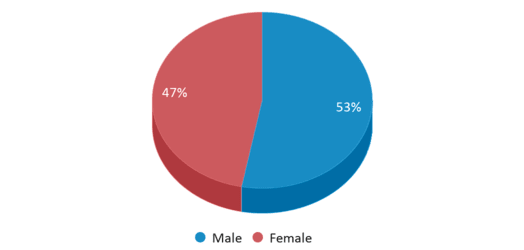
Total Classroom Teachers
65 teachers
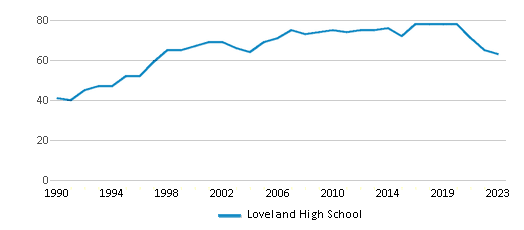
Students by Grade
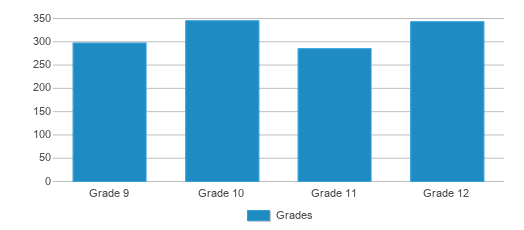
School Rankings
Loveland High School ranks within the top 20% of all 3,241 schools in Ohio (based off of combined math and reading proficiency testing data).
The diversity score of Loveland High School is 0.22, which is less than the diversity score at state average of 0.53. The school's diversity has stayed relatively flat over five school years.
Overall Testing Rank
#592 out of 3241 schools
(Top 20%)
(Top 20%)
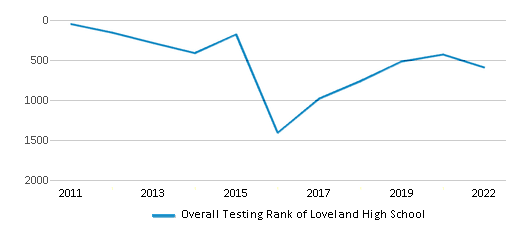
Math Test Scores (% Proficient)
64%
52%

Reading/Language Arts Test Scores (% Proficient)
85%
60%
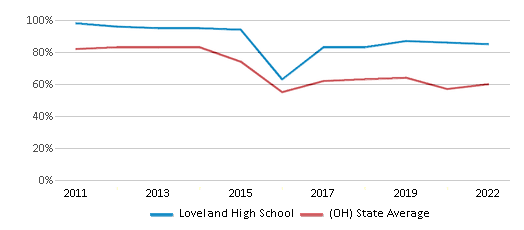
Science Test Scores (% Proficient)
88%
63%
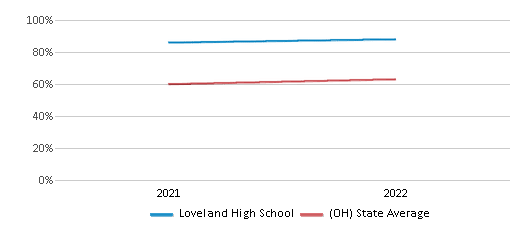
Student : Teacher Ratio
20:1
17:1
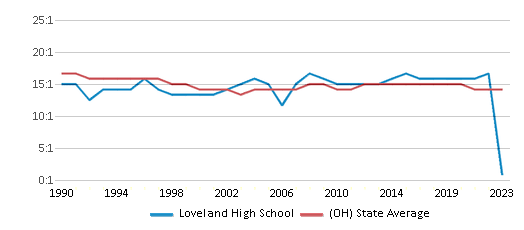
American Indian
n/a
n/a
Asian
3%
3%
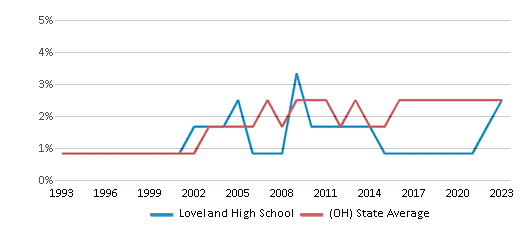
Hispanic
4%
8%
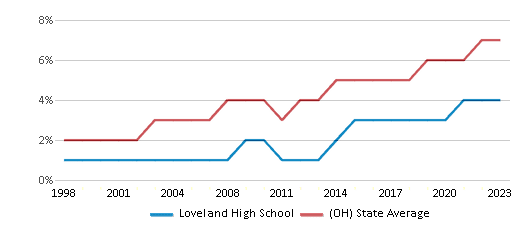
Black
2%
17%
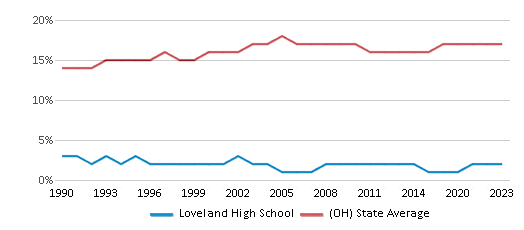
White
88%
66%
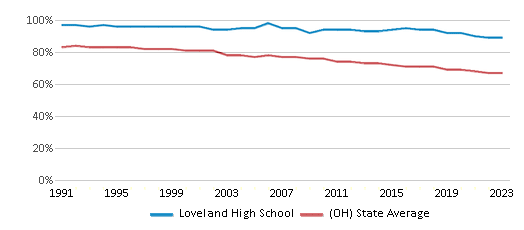
Hawaiian
n/a
n/a
Two or more races
3%
6%
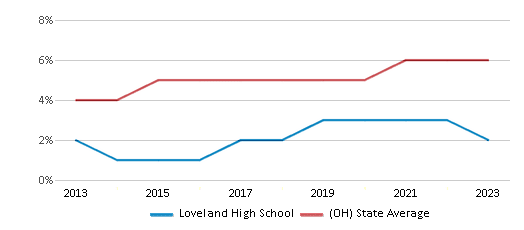
All Ethnic Groups

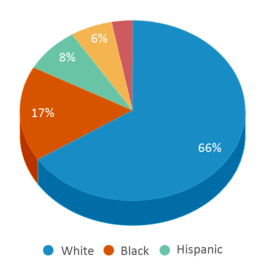
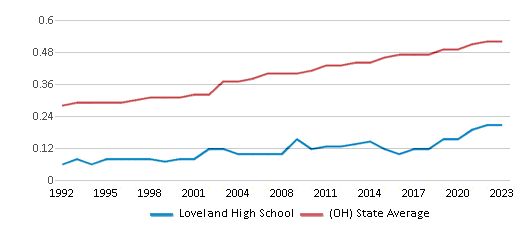
Graduation Rate
98%
86%

Participates in the National School Lunch Program (NSLP)
Yes
Eligible for Free Lunch
8%
42%
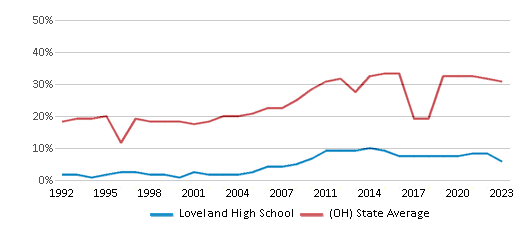
Eligible for Reduced Lunch
3%
5%
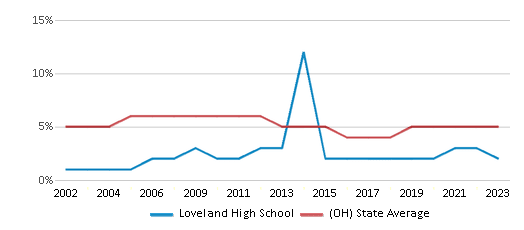
School Statewide Testing
School District Name
Source: National Center for Education Statistics (NCES), OH Dept. of Education
Profile last updated: 02/09/2025
Frequently Asked Questions
What is Loveland High School's ranking?
Loveland High School is ranked #592 out of 3,241 schools, which ranks it among the top 20% of public schools in Ohio.
What schools are Loveland High School often compared to?
Loveland High Schoolis often viewed alongside schools like Kings High School, Milford Sr High School by visitors of our site.
What percent of students have achieved state testing proficiency in math and reading?
64% of students have achieved math proficiency (compared to the 52% OH state average), while 85% of students have achieved reading proficiency (compared to the 60% OH state average).
What is the graduation rate of Loveland High School?
The graduation rate of Loveland High School is 98%, which is higher than the Ohio state average of 86%.
How many students attend Loveland High School?
1,270 students attend Loveland High School.
What is the racial composition of the student body?
88% of Loveland High School students are White, 4% of students are Hispanic, 3% of students are Asian, 3% of students are Two or more races, and 2% of students are Black.
What is the student:teacher ratio of Loveland High School?
Loveland High School has a student ration of 20:1, which is higher than the Ohio state average of 17:1.
What grades does Loveland High School offer ?
Loveland High School offers enrollment in grades 9-12
What school district is Loveland High School part of?
Loveland High School is part of Loveland City School District.
School Reviews
1 4/27/2020
Rampant bullying and not a damn thing done about it.
5 9/28/2013
I've had three sons go through Loveland, would recommend to anyone. I like the small school feel although it's grown up a lot. We often call Loveland "Mayberry" because everybody knows everybody and great community feel. The school is small enough that your kid can participate, mine did everything from football to band to the National Champ Show Choir. Loveland passed last funding bill 2 to 1 while other reputable districts are having a hard time. I could go on and on, but this is a great school system.
5 4/20/2010
The academics are awesome and cater to students needs. There are many programs during and after school to get involved in and parent involvement all depends on the parent.
Review Loveland High School. Reviews should be a few sentences in length. Please include any comments on:
- Quality of academic programs, teachers, and facilities
- Availability of music, art, sports and other extracurricular activities
Recent Articles

What Is A Charter School?
Explore the world of charter schools in this comprehensive guide. Learn about their history, how they operate, and the pros and cons of this educational innovation. Discover key facts about charter schools, including admission policies, demographics, and funding, as well as what to look for when considering a charter school for your child.

10 Reasons Why High School Sports Benefit Students
Discover the 10 compelling reasons why high school sports are beneficial for students. This comprehensive article explores how athletics enhance academic performance, foster personal growth, and develop crucial life skills. From improved fitness and time management to leadership development and community representation, learn why participating in high school sports can be a game-changer for students' overall success and well-being.

February 05, 2025
Understanding the U.S. Department of Education: Structure, Impact, and EvolutionWe explore how the Department of Education shapes American education, from its cabinet-level leadership to its impact on millions of students, written for general audiences seeking clarity on this vital institution.





